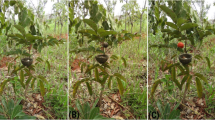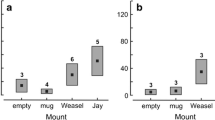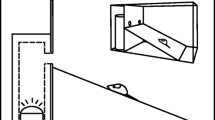Abstract
We explore for the first time the relative importance of chemical and visual cues of predators in nest defense and antipredator behavior in a hole-nesting songbird, the blue tit Cyanistes caeruleus. Birds breeding in nest boxes were exposed to chemical or visual cues of a predatory and a non-predatory mammal during the nestling stage, and their behavior both outside and inside nest boxes was recorded with video films. Our results show that birds respond equally to chemical and to visual cues of predators in a context of nest defense. Adult birds minimized predation risk by decreasing the time spent inside the nest box while feeding nestlings when they were exposed to either visual or chemical cues of a mammalian predator. They decreased the time spent in non-essential activities for nestlings’ survival, such as nest sanitation activities, but they maintained provisioning rates so that the nestlings’ growth was not compromised. In this way, birds minimized the risk of predation while provisioning nestlings when a predator was detected in the vicinity of their nest.
Significant statement
We explored the role of predator chemical and visual cues for risk assessment in blue tits. Our results showed for the first time that birds respond equally to chemical and to visual cues of mammalian predators. Birds decreased time exposed to predation risk when entering the nest box to feed the nestlings. They reduced time spent in non-essential activities for nestling survival, such as nest sanitation. However, they maintained provisioning rates so that nestling growth was not impaired.


Similar content being viewed by others
References
Amo L, López P, Martín J (2004) Wall lizards combine chemical and visual cues of ambush snake predators to avoid overestimating risk inside refuges. Anim Behav 67:647–653
Amo L, López P, Martín J (2005) Chemical assessment of predation risk in the wall lizard, Podarcis muralis, is influenced by time exposed to chemical cues of ambush snakes. Herpetol J 15:21–25
Amo L, Galván I, Tomás G, Sanz JJ (2008) Predator odour recognition and avoidance in a songbird. Funct Ecol 22:289–293
Amo L, Visser ME, van Oers K (2011a) Smelling out predators is innate in birds. Ardea 99:188–184
Amo L, Caro SP, Visser ME (2011b) Sleeping birds do not respond to predator odour. PLoS One 6:e27576
Amo L, López-Rull I, Pagán I, Macías-Garcia C (2015) Evidence that the house finch (Carpodacus mexicanus) uses scent to avoid omnivore mammals. Rev Chil Hist Nat 88:5
Apfelbach R, Blanchard CD, Blanchard RJ, Hayes RA, McGregor IS (2005) The effects of predator odors in mammalian prey species: a review of field and laboratory studies. Neurosc Biobehav Rev 29:1123–1144
Brown GE, Magnavacca G (2003) Predator inspection behaviour in a characin fish: an interaction between chemical and visual information? Ethology 109:739–750
Chivers DP, Smith RJF (1998) Chemical alarm signalling in aquatic predator/prey systems: a review and prospectus. Ecoscience 5:338–352
Chivers DP, Mirza RS, Bryer PS, Kiesecker JM (2001) Threat-sensitive predator avoidance by slimy sculpins: understanding the importance of visual versus chemical information. Can J Zool 79:867–873
Cramp S, Perrins CM (1993) Handbook of the birds of Europe, the Middle East and North Africa. The birds of the Western Palearctic. Vol. VII. Flycatchers to shrikes. Oxford Univ Press, Oxford
Eichholz MW, Dassow JA, Stafford JD, Weatherhead PJ (2012) Experimental evidence that nesting ducks use mammalian urine to assess predator abundance. Auk 129:638–644
Garamszegi LZ, Eens M, Török J (2009) Behavioural syndromes and trappability in free-living collared flycatchers, Ficedula albicollis. Anim Behav 77:803–812
García-Navas V, Sanz JJ (2010) Flexibility in the foraging behavior of blue tits in response to short-term manipulations of brood size. Ethology 116:744–754
Godard RD, Bowers BB, Wilson CM (2007) Eastern bluebirds Sialia sialis do not avoid nest boxes with chemical cues from two common nest predators. J Avian Biol 38:128–131
Gonzálvez FG, Rodríguez-Gironés MA (2013) Seeing is believing: information content and behavioural response to visual and chemical cues. Proc R Soc B 280:20130886
Hartman EJ, Abrahams MV (2000) Sensory compensation and the detection of predators: the interaction between chemical and visual information. Proc R Soc Lond B 267:571–575
Helfman GS (1989) Threat-sensitive predator avoidance in damselfish-trumpetfish interactions. Behav Ecol Sociobiol 24:47–58
Hemmi JM (2005) Predator avoidance in fiddler crabs: 2. The visual cues. Anim Behav 69:615–625
Hettena A, Blumstein DT, Munoz N (2014) Prey responses to predator’s sounds: a review and empirical study. Ethology 120:427–452
Hettyey A, Rölli F, Thürlimann N, Zürcher A, Van Buskirk J (2012) Visual cues contribute to predator detection in anuran larvae. Biol J Linn Soc 106:820–827
Hund AK, Aberle MA, Safran RJ (2015) Do parents alter provisioning rates across the nestling period in response to ectoparasites: an experimental test in the North American barn swallow Hirundo rustica erythrogaster. Anim Behav 110:187–196
Hurtrez-Boussès S, Renaud F, Blondel J, Perret P, Galán MJ (2000) Effects of ectoparasites of young on parents’ behaviour in a Mediterranean population of blue tits. J Avian Biol 31:266–269
Ibáñez-Álamo JD, Sanllorente O, Arco L, Soler M (2013) Is nest predation an important selective pressure determining fecal sac removal? Ann Zool Fenn 50:71–78
Johnson LS, Murphy SM, Parrish GW (2011) Lack of predator-odor detection and avoidance by a songbird, the house wren. J Field Ornithol 82:150–157
Kats LB, Dill LM (1998) The scent of death: chemosensory assessment of predation risk by prey animals. Ecoscience 5:361–394
Kiesecker JM, Chivers DP, Anderson M, Blaustein AR (2002) Effect of predator diet on life history shifts of red-legged frogs, Rana aurora. J Chem Ecol 28:1007–1015
Knight RL, Temple SA (1986) Why does intensity of avian nest defense increase during the nesting cycle? Auk 103:318–327
Krams I, Krama T, Igaune K, Mänd R (2007) Long-lasting mobbing of the pied flycatcher increases the risk of nest predation. Behav Ecol 18:1082–1084
Krystofkova M, Haas M, Exnerova A (2011) Nest defense in blackbirds Turdus merula: effect of predator distance and parental sex. Acta Ornithol 46:55–63
Lohrey AK, Clark DL, Gordon SD, Uetz GW (2009) Antipredator responses of wolf spiders (Araneae: Lycosidae) to sensory cues representing an avian predator. Anim Behav 77:813–821
López-Rull I, Macías Garcia C (2015) Control of invertebrate occupants of nests. In: Deeming DC, Reynolds SJ (eds) Nests, eggs, and incubation. Oxford University Press, Oxford, pp 82–96
MacLean SA, Bonter DN (2013) The sound of danger: threat sensitivity to predator vocalizations, alarm calls, and novelty in gulls. PLoS One 8:e82384
Mathis A, Vincent F (2000) Differential use of visual and chemical cues in predator recognition and threat-sensitive predator-avoidance responses by larval newts (Notophthalmus viridescens). Can J Zool 78:1646–1652
Merino S (2010) Immunocompetence and parasitism in nestlings from wild populations. Open Ornithol J 3:27–32
Møller AP, Arriero E, Lobato E, Merino S (2009) A review of parasite virulence in nestling birds. Biol Rev 84:561–588
Mönkkönen M, Forsman JT, Kananoja T, Ylönen H (2009) Indirect cues of nest predation risk and avian reproductive decisions. Biol Let 5:176–178
Mutzel A, Blom MPK, Spagopoulou F, Wright J, Dingemanse NJ, Kempenaers B (2013) Temporal trade-offs between nestling provisioning and defence against nest predators in blue tits. Anim Behav 85:1459–1469
R Development Core Team (2012) R: A Language and environment for statistical computing. R Foundation for Statistical Computing, Vienna, http://www.r-project.org
Roth TC, Cox JG, Lima SL (2008) Can foraging birds assess predation risk by scent? Anim Behav 76:2021–2027
Seppänen JT, Forsman JT, Mönkkönen M, Krams I, Salmi T (2011) New behavioural trait adopted or rejected by observing heterospecific tutor fitness. Proc R Soc Lond B 278:1736–1741
Smith ME, Belk MC (2001) Risk assessment in western mosquitofish (Gambusia affinis): do multiple cues have additive effects? Behav Ecol Sociobiol 51:101–107
Suzuki TN (2014) Communication about predator type by a bird using discrete, graded and combinatorial variation in alarm calls. Anim Behav 87:59–65
Suzuki TN, Ueda K (2013) Mobbing calls of Japanese tits signal predator type: field observations of natural predator encounters. Wilson J Ornithol 125:412–415
Takahara T, Kohmatsu Y, Maruyama A, Doi H, Yamanaka H, Yamaoka R (2012) Inducible defense behavior of an anuran tadpole: cue-detection range and cue types used against predator. Behav Ecol 23:863–868
Tang L, Schwarzkopf L (2013) Foraging behaviour of the peaceful dove (Geopelia striata) in relation to predation risk: group size and predator cues in a natural environment. Emu 113:1–7
Thomson RL, Forsman JT, Mönkkönen M (2011) Risk taking in natural predation risk gradients: support for risk allocation from breeding pied flycatchers. Anim Behav 82:1443–1447
Tvardíková K, Fuchs R (2011) Tits recognize the potential dangers of predators and harmless birds in feeder experiments. J Ethol 30:157–165
Vilhunen S, Hirvonen H (2003) Innate antipredator responses of Arctic charr (Salvelinus alpinus) depend on predator species and their diet. Behav Ecol Sociobiol 55:1–10
Wegmann M, Voegeli B, Richner H (2015) Physiological responses to increased brood size and ectoparasite infestation: adult great tits favour self-maintenance. Physiol Behav 141:127–134
Wesolowski T, Maziarz M (2012) Dark tree cavities—a challenge for hole nesting birds? J Avian Biol 43:454–460
Wiklund C, Andersson M (1980) Nest predation selects for colonial breeding among fieldfares Turdus pilaris. Ibis 122:363–366
Zhang JX, Sun LX, Novotny M (2007) Mice respond differently to urine and its major volatile constituents from male and female ferrets. J Chem Ecol 33:603–612
Zidar J, Løvlie H (2012) Scent of the enemy: behavioural responses to predator faecal odour in the fowl. Anim Behav 84:547–554
Acknowledgements
We especially thank Paz Manzano for English corrections. We thank anonymous referees that help us to improve the manuscript with their comments.
Author information
Authors and Affiliations
Corresponding author
Ethics declarations
Funding
LA was supported by the Ramón y Cajal program and the CGL2014-58890-P project. GT was partly supported by the Ramón y Cajal program.
Conflict of interest
The authors declare that they have no conflict of interest.
Ethical statement
No nest was deserted during the course of the experiment. Results of a previous study showed that exposure to predator chemical cues did not affect body condition of blue tit nestlings, even when cues were located inside nest boxes (Amo et al. 2008). The experiment was conducted under license issued by the Instituto Aragonés de Gestión Ambiental (INAGA/500201/24/2013/11743).
Additional information
Communicated by S. Pruett-Jones
Rights and permissions
About this article
Cite this article
Amo, L., Tomás, G. & López-García, A. Role of chemical and visual cues of mammalian predators in nest defense in birds. Behav Ecol Sociobiol 71, 49 (2017). https://doi.org/10.1007/s00265-017-2281-9
Received:
Revised:
Accepted:
Published:
DOI: https://doi.org/10.1007/s00265-017-2281-9




